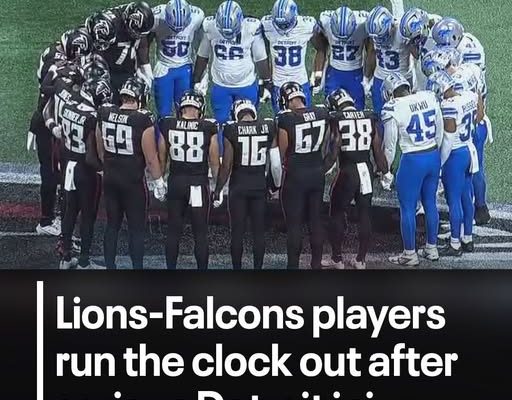In their second preseason matchup of the 2025 NFL season, the Detroit Lions and the Atlanta Falcons faced off in a game that was meant to showcase depth, assess talent, and provide fans with an early glimpse of what to expect in the regular season. Preseason games often carry a different weight than regular-season contests; they are largely about evaluation rather than wins and losses. Yet, this particular contest quickly became about much more than strategy, player performance, or scoring drives. What unfolded was a tense, emotionally charged game that would be remembered not for its offensive fireworks but for a heartbreaking injury that cast a shadow over the evening.
From the opening kickoff, both teams demonstrated that they were ready to compete and that no preseason game would be taken lightly. The Lions, under the leadership of their coaching staff, looked to build momentum and test out some of their young talent, particularly at skill positions and along the offensive line. Meanwhile, the Falcons, eager to establish continuity under their system and evaluate their roster depth, approached the game with a balance of aggression and caution. The initial drives reflected this mindset: both teams traded a mix of short completions, steady rushing attempts, and solid defensive stops. The intensity of play, even in preseason, highlighted the competitive nature of these athletes and the seriousness with which they treated each opportunity to impress their coaches.
As the game progressed, the scoreline remained tight. Neither team was willing to cede advantage, despite the game technically not counting toward standings or playoff positioning. For Detroit, their offensive unit showed flashes of cohesion, with quarterback play marked by crisp throws and quick decision-making. Running backs showcased their ability to find creases and accelerate through gaps, while wide receivers made contested catches that hinted at the potential for big plays once the regular season began. On the defensive side, the Lions’ front seven applied pressure, disrupting timing and forcing hurried throws. Their secondary was tested repeatedly, showing a mix of experience and raw athleticism, with some standout moments in coverage that suggested the backfield could be a strength if injuries are avoided during the regular season.
The Falcons mirrored this energy, leaning on a blend of veteran leadership and young talent. Their quarterback rotation included both established starters and promising rookies, giving fans a look at how the team might evolve over the season. The offensive line, while still adjusting to new personnel, demonstrated solid run-blocking schemes, allowing the team to generate momentum on early drives. Atlanta’s receivers made several impressive catches, some requiring remarkable adjustments to secure the ball while navigating tight coverage. Defensively, the Falcons were aggressive in their approach, blitzing in calculated packages to pressure the quarterback and testing the Lions’ protection schemes. Both teams were executing at a level that made it clear that despite being preseason, no one intended to treat the contest as merely an exhibition.
The turning point of the game, however, was not a tactical adjustment or a pivotal turnover. It came in the form of a distressing injury that occurred late in the second half. While exact details initially remained uncertain, the severity was immediately apparent. Medical personnel rushed onto the field, signaling the gravity of the situation. Players from both teams expressed visible concern, with teammates gathering around to offer support. Fans in the stadium fell silent, recognizing that even in preseason, injuries are an unfortunate reality of the sport and can dramatically alter the trajectory of a team’s season. The emotional impact of the incident resonated widely, as commentators paused to reflect on the human element of football, reminding viewers and attendees alike that behind the athletic prowess and game-day spectacle are individuals whose careers and lives can be affected in an instant.
Following the injury, the game’s pace slowed considerably. Both teams allowed the clock to run out while attention focused on the well-being of the injured player. In scenarios like this, the competitive aspect of the game often takes a backseat to concern and protocol, and the Lions and Falcons demonstrated professionalism in ensuring the player received the necessary care. Ultimately, officials made the difficult decision to suspend the game entirely. While the decision was disappointing for fans hoping to see a complete contest, it underscored the league’s commitment to player safety and well-being—a priority that outweighs any scoreline or preseason evaluation. The suspension left coaches, players, and fans with a sense of incompleteness, a game that promised so much but ended under somber circumstances.
From a coaching perspective, the suspension created challenges in terms of evaluating performance. Preseason matchups are critical for assessing younger players, testing schemes, and gauging readiness for the regular season. The abrupt ending deprived both coaching staffs of valuable tape and data, forcing them to adjust plans for future games and practices. Coaches must now consider how to balance ongoing player development with ensuring that athletes have recovered fully from the incident. This kind of disruption can impact depth charts, rotations, and roster decisions, highlighting how a single event can ripple throughout a team’s preparation and strategy for the season ahead.
The broader implications for both franchises are multifaceted. For Detroit, the injury raises concerns about maintaining offensive and defensive continuity if a key player is sidelined for an extended period. The Lions have invested heavily in certain positions, and the loss of a contributor—especially early in the preseason—can complicate efforts to establish rhythm and cohesion. Atlanta faces a similar predicament, with their roster evaluation and player readiness impacted by the unexpected halt. Both teams now need to reassess practice intensity, recovery protocols, and player availability, ensuring that athletes return safely to compete in upcoming games. This incident serves as a reminder that the NFL’s physical demands require not only skill but resilience, preparation, and sometimes, sheer luck in avoiding injuries that can derail plans.
Fan reactions to the game have been a mix of concern and support. Social media platforms quickly filled with messages expressing hope for a speedy recovery, while also analyzing the game’s limited highlights and potential implications for the season. Preseason games are often overlooked compared to regular-season matchups, but events like this highlight their significance, both in terms of player evaluation and the emotional investment of fans. Spectators were reminded that each contest, regardless of its official weight, carries stakes beyond wins and losses, as every snap represents real consequences for the athletes on the field.
Media coverage has naturally focused on the injury, with updates expected in the coming days regarding the player’s condition and projected recovery timeline. Analysts and reporters are discussing both the immediate effects on the team rosters and the broader implications for the preseason schedule. Suspended games are rare, and when they occur, they prompt conversations about league policies, player safety protocols, and the responsibility of teams and officials to prioritize health over competition. This incident serves as a case study in balancing competitive integrity with ethical considerations, reinforcing the importance of maintaining standards that protect players while still allowing the game to proceed in a meaningful way.
For the players themselves, the experience was a stark reminder of the risks inherent in professional football. Even in a controlled environment like a preseason game, injuries can occur at any moment, affecting careers and livelihoods. Teammates and opponents alike demonstrated solidarity, offering support and acknowledging the shared vulnerability of athletes in a contact sport. This camaraderie, often overlooked in the context of wins and losses, is a vital component of team culture and player morale. How the Lions and Falcons respond in the aftermath—both in terms of player recovery and team cohesion—will be an important storyline as the season progresses.
Looking ahead, both teams will need to focus on recovery, reassessment, and preparation for the next preseason games. Adjustments in practice regimens, play-calling, and player rotations will likely be necessary to accommodate any absences and ensure the team remains competitive. Coaches will use film from the portions of the game that were completed to glean insights, though the suspension means that some evaluation opportunities were lost. This makes the remaining preseason matchups even more critical, as teams attempt to finalize rosters and identify players capable of contributing immediately when the regular season begins.
In conclusion, what started as a routine preseason contest between the Detroit Lions and the Atlanta Falcons transformed into a moment of collective concern and reflection due to a heartbreaking injury. The game, ultimately suspended in its final moments, serves as a reminder of the human element in professional sports, where preparation, skill, and strategy coexist with vulnerability and unpredictability. While fans were deprived of a complete contest, the priority of player safety was rightfully upheld, emphasizing that no game result outweighs the well-being of athletes. Both franchises now face the dual task of supporting the injured player and recalibrating their preseason plans, while fans and analysts will continue to monitor updates closely. This incident underscores the delicate balance of competition and care in the NFL, reminding all involved that every game, every snap, and every play carries significance beyond the scoreboard, shaping careers, team dynamics, and the shared experience of the sport itself.



